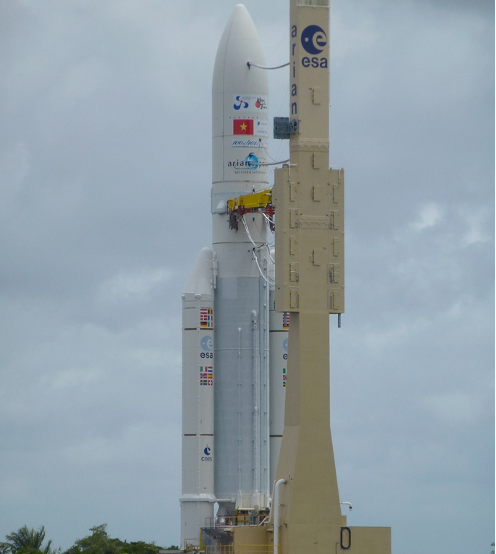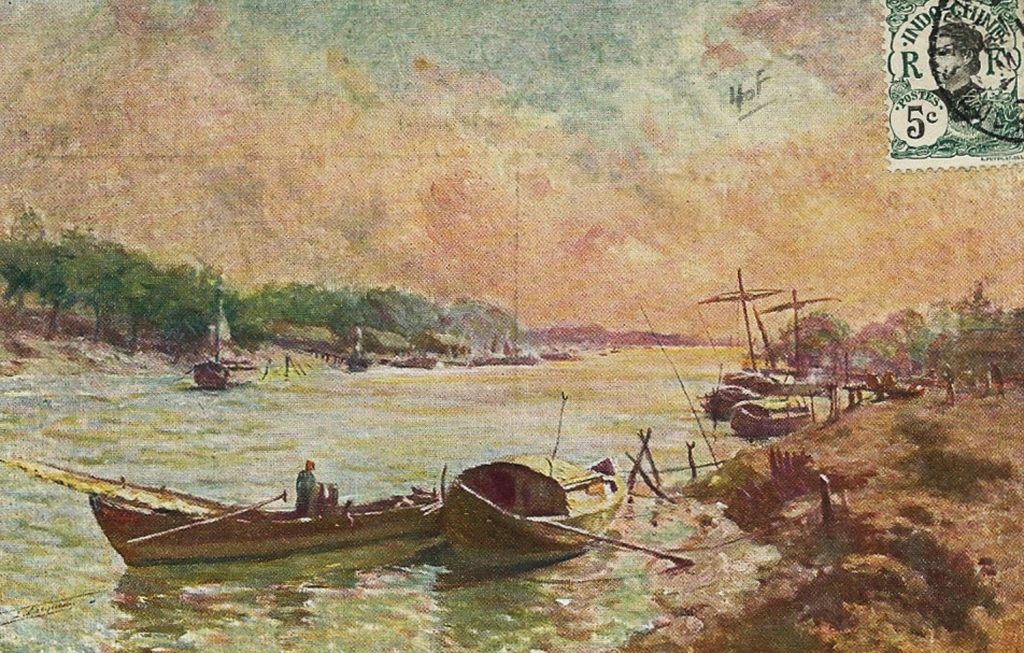On April 18 2008, Vietnamese journalist Danh Đức was standing in the rain at the Kourou Space Centre, the European Space Agency’s spaceport in French Guiana, a territory that is, as an overseas département, still an integral part of France. Eyes heavenward, Danh Đức was eager to witness the launch of Vinasat-1, the first Vietnamese satellite. Vietnam’s Post and Telecommunications Ministry had previously rented space on other countries’ satellites, but Vinasat-1, an indication of the Socialist Republic of Vietnam’s growing economic strength, would not only save government money, but “put Vietnam in a more central role on the world stage.”[1] The restructuring polices of the Socialist Republic of Vietnam in the late 1980s changed the landscape of the Vietnamese economy from a centrally planned to a market economy and Vietnam had become one of Asia’s fastest growing economies.[2]
With the launch positioned as “a memorable landmark in the country’s development and integration [into the world community],”[3] Danh Đức had been sent to Kourou to write a first-hand account for Youth, a Hồ Chí Minh City-based newspaper with the largest circulation in Vietnam. Given the dearth of interaction between French Guiana and the Socialist Republic of Vietnam, and their radically different trajectories in terms of French colonialism, a Vietnamese journalist appearing in French Guiana was unusual.

In his later description of this momentous day, Danh Đức narrated: “as I was standing in pouring rain watching the Ariane-5 rocket propelling the satellite into skies, I suddenly heard someone call out to me in French: “Are you Vietnamese?” Danh Đức turned to see an elderly security guard looking at him. He described the guard “as having slightly dark skin but eyes sharp with joy. At that point the guard said to me in Vietnamese: ‘I’m Vietnamese too! My name is Trần Văn Cân.”
Danh Đức’s chance encounter with Trần Văn Cân was revelatory. Initially unable to fathom how a Vietnamese man came to be working as a guard in the Kourou Space Centre, Danh Đức remembered from cursory historical reading that during the French colonial period in Vietnam political exiles were deported to French Guiana after an uprising in 1930. He assumed Trần Văn Cân was descended from one of those exiles. However, when Danh Đức questioned him, Trần Văn Cân related that his father had been born in French Guiana in 1922 after his grandfather had been exiled there at the end of the 19th century. He was the third generation of Vietnamese men all bearing the same name: Trần Văn Cân.

Reading of that first encounter, with just a few clicks of the computer, the contemporary researcher can read the prisoner file of the original Trần Văn Cân. The digitized colonial records of the Archives nationales d’outre mer in Aix-en-Provence contain thousands of such prisoner files. Trần Văn Cân’s file is unusual in that it was written en route from French Indochina, in the Algerian prison of El Harrach (sometimes spelt Harruch in French documents) which still exists today in a suburb of Algiers. Prisoners from French Indochina would have been taken there by train from the harbour of Algiers, to await their onward shipment.
The prisoner file tells us just a few details about this young man who was born in Phước Vinh, southern Vietnam. Found guilty of murder in 1907 at the age of 29, Trần Văn Cân was imprisoned for five years before being sent to French Guiana. The circumstances of his crime are not known but he left behind two children in Phước Vinh where he made matchboxes to eke out a living and, like most of his compatriots, his file lists him as “illiterate.”
He died in 1926 and his son Josapha Tran Van Can was born six years earlier in 1920 (not 1922 as our Kourou guard, his grandson, remembered.) In turn Josapha married the daughter of a French prisoner from Autruche, northern France called Angele Olga Senzer (she was the one born in 1922 which is perhaps why this year was significant in family lore.)
As these details illustrate, genealogical information has become much easier to find since Danh Đức’s encounter in 2008, at a time when Danh had no idea that Vietnamese deportation to French Guiana pre-dated 1930. In fact, nearly ten thousand Vietnamese prisoners were deported to different areas of the French empire between 1863 and 1941; Trần Văn Cân was just one of them.
As a result of this revelation, Danh Đức went on a tour of French Guiana to meet other descendants of Vietnamese prisoners. He also visited Cirque Anguille, an area of French Guiana now referred to as the “Penal Colony of the Vietnamese”. There, Danh Đức lit incense for the ghosts of the dead convicts and claimed that the “heady smell of fragrant incense drove away the cold of the jungle which had been forgotten for nearly a century.” He also mentioned that he was keen to placate the spirits of the Vietnamese prisoners. He presumed they were now “hungry ghosts” susceptible to the pain of “a wandering fate,” (số phận lưu lạc.)
Danh Đức’s reference to the prisoners being forgotten for nearly a century has a certain historical accuracy. There has been little research into these prisoners, and they have been omitted from most texts published in Vietnam, except for one brief historical survey in 1957.[4] However, in the last ten years more researchers, myself included and other British, French and Vietnamese have published articles and stories on the Vietnamese prisoners of French Guiana. Work with archives and oral histories is constantly unfolding. The “wandering fates” of these prisoners from French Indochina are being traced with all the digital tools available to researchers in 2024. As for the family of the three Tran Van Cans, the incense on the ancestral altar has always burned brightly, the matchbox maker from Phước Vinh never forgotten.
Lorraine M. Paterson
Sources
Danh Đức’s text is titled Nhà Lao Annam ở Guyane, [The Vietnamese Prison in Guiana] T.P.Hồ Chí Mịnh: Nhà Bản Trẻ, 2008, Xuât. All the passages were translated by the author.
[1] Vinasat-2 launched in July 2012.
[2]There is an extensive literature on these economic changes. For example, Socioeconomic Renovation in Viet Nam: The Origin, Evolution and Impact of đổi mới ed. Peter Boothroyd and Pham Xuan Nam, Singapore: Institute of Southeast Asian Studies, 2000.
[3] Nhân Dân, newspaper, April 15, 2008.
[4] Hoàng Văn Đào’s Từ Yên-Bái đến các ngục-thất Hà-Nội, Côn-Nôn, Guy-An, Saigon: Nhà xuất bản sống mới, 1957.